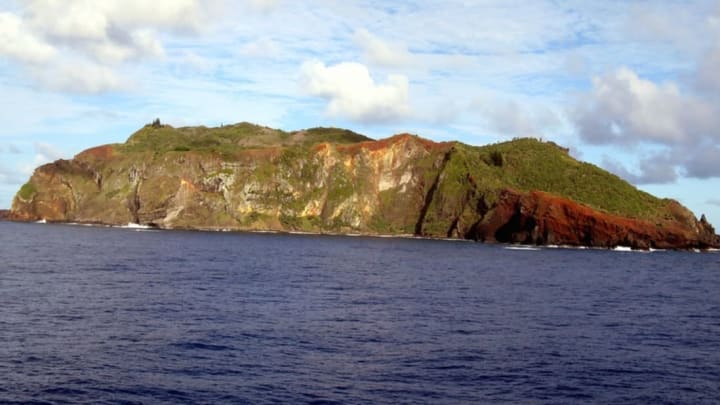Looking for an escape from crowded streets, polluted air, and the constant reminder of our consumer driven society? Look no further than Pitcairn Island, a British Overseas Territory in the South Pacific with a tiny population, beautiful scenery, and barely anything to do. It only takes a plane ride to Tahiti, another to Mangareva, then a ferry ride, and a 32 hour ocean crossing on the Claymore II to arrive to your final destination. It's the perfect vacation spot.
1. It’s tiny and isolated.
Although the Pitcairn Islands group includes three other islands—Henderson, Ducie, and Oeno—Pitcairn is the only one inhabited by people. The island measures about 2 miles long and 1 mile wide, and the population hit its peak in the 1930s, when 200 people lived on the island. Since then, it's dwindled to about 50.
The island’s administrative headquarters is located 3300 miles away in Auckland, New Zealand, and the only way to access the island's capital of Adamstown is by taking a road called "The Hill of Difficulty."
2. No one wants to move there.
In February, the Telegraph reported that due to an aging population, the island is actively looking for new settlers as part of the official 2014-2019 Repopulation Plan [PDF]. Even though land is free, the summer temperature ranges between 60 and 86 degrees Fahrenheit, and the lowest winter temperature is around 62 degrees, only one person had applied for a visa at the time of the article’s publication.
3. It was almost settled in 1767.
In July 1767, English Captain Philip Carteret recorded his sighting of the island, but was unable to land due to violent waters. However, he recorded what he thought was the longitude and latitude of the location, and passed on his information to Captain Cook. Had Cook not been deterred by scurvy, he would have been disappointed to find that the island wasn’t where Cateret had promised: The longitude was off by three degrees, or a full two days of sailing.
The island was officially settled in 1790, when a group of eight mutineers led by Fletcher Christian of the HMS Bounty and their Tahitian “companions” (who were treated more like slaves) arrived after fleeing the British naval law. The "Mutiny on the Bounty" was depicted in a film of the same name, first starring Clark Gable in 1935, and then again with Marlon Brando in the lead in 1962.
The island’s current inhabitants are almost all descendants of the mutineers and Tahitians.
4. The Europeans weren’t the island’s first inhabitants
Although no one is entirely sure where the early settlers were from, the island’s proximity to the French Polynesian island Mangareva, as well as artifacts like stone gods, human skeletal remains, and earth ovens found around the island have led many to believe that they were of Polynesian descent. Some of these artifacts are on display in the Pitcairn Island museum.
5. There are few attractions.
Aside from hiking and observing the natural beauty—well represented on Google Map's street view— there is little else by way of tourist attractions. The Tourism Board advertises the General Store, the Museum, and the Church as three of the main “points of interest.” There is also a coffee shop named Oh Dear, which reviewers have given an average of 4.7 stars.
